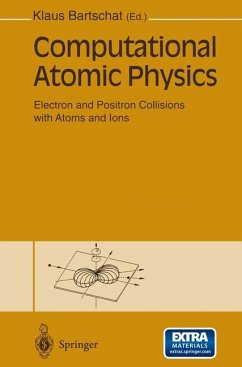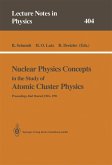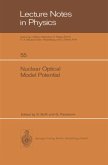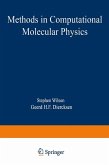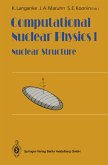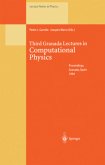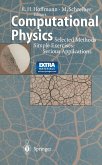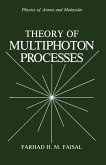Computational Atomic Physics
Electron and Positron Collisions with Atoms and Ions
Herausgegeben:Bartschat, Klaus;Mitarbeit:Bartschat, K.; McCarthy, I. E.; McEachran, R. P.; Madison, D.H; Xixiang, Z.
Computational Atomic Physics
Electron and Positron Collisions with Atoms and Ions
Herausgegeben:Bartschat, Klaus;Mitarbeit:Bartschat, K.; McCarthy, I. E.; McEachran, R. P.; Madison, D.H; Xixiang, Z.
- Broschiertes Buch
- Merkliste
- Auf die Merkliste
- Bewerten Bewerten
- Teilen
- Produkt teilen
- Produkterinnerung
- Produkterinnerung
Computational Atomic Physics deals with computational methods for calculating electron (and positron) scattering from atoms and ions, including elastic scattering, excitation, and ionization processes. Each chapter is divided into abstract, theory, computer program with sample input and output, summary, suggested problems, and references. An MS-DOS diskette is included, which holds 11 programs covering the features of each chapter and therefore contributing to a deeper understanding of the field. Thus the book provides a unique practical application of advanced quantum mechanics.
Andere Kunden interessierten sich auch für
![Nuclear Physics Concepts in the Study of Atomic Cluster Physics Nuclear Physics Concepts in the Study of Atomic Cluster Physics]() Nuclear Physics Concepts in the Study of Atomic Cluster Physics77,99 €
Nuclear Physics Concepts in the Study of Atomic Cluster Physics77,99 €![Nuclear Optical Model Potential Nuclear Optical Model Potential]() Nuclear Optical Model Potential39,99 €
Nuclear Optical Model Potential39,99 €![Methods in Computational Molecular Physics Methods in Computational Molecular Physics]() Methods in Computational Molecular Physics77,99 €
Methods in Computational Molecular Physics77,99 €![Computational Nuclear Physics 1 Computational Nuclear Physics 1]() Computational Nuclear Physics 138,99 €
Computational Nuclear Physics 138,99 €![Third Granada Lectures in Computational Physics Third Granada Lectures in Computational Physics]() Third Granada Lectures in Computational Physics75,99 €
Third Granada Lectures in Computational Physics75,99 €![Computational Physics Computational Physics]() Computational Physics39,99 €
Computational Physics39,99 €![Theory of Multiphoton Processes Theory of Multiphoton Processes]() Farhad H.M. FaisalTheory of Multiphoton Processes153,99 €
Farhad H.M. FaisalTheory of Multiphoton Processes153,99 €-
-
-
Computational Atomic Physics deals with computational methods for calculating electron (and positron) scattering from atoms and ions, including elastic scattering, excitation, and ionization processes. Each chapter is divided into abstract, theory, computer program with sample input and output, summary, suggested problems, and references. An MS-DOS diskette is included, which holds 11 programs covering the features of each chapter and therefore contributing to a deeper understanding of the field. Thus the book provides a unique practical application of advanced quantum mechanics.
Produktdetails
- Produktdetails
- Verlag: Springer / Springer Berlin Heidelberg / Springer, Berlin
- Artikelnr. des Verlages: 978-3-642-64655-3
- Softcover reprint of the original 1st ed. 1996
- Seitenzahl: 272
- Erscheinungstermin: 23. August 2014
- Englisch
- Abmessung: 235mm x 155mm x 15mm
- Gewicht: 417g
- ISBN-13: 9783642646553
- ISBN-10: 3642646557
- Artikelnr.: 41322827
- Herstellerkennzeichnung
- Springer-Verlag GmbH
- Tiergartenstr. 17
- 69121 Heidelberg
- ProductSafety@springernature.com
- Verlag: Springer / Springer Berlin Heidelberg / Springer, Berlin
- Artikelnr. des Verlages: 978-3-642-64655-3
- Softcover reprint of the original 1st ed. 1996
- Seitenzahl: 272
- Erscheinungstermin: 23. August 2014
- Englisch
- Abmessung: 235mm x 155mm x 15mm
- Gewicht: 417g
- ISBN-13: 9783642646553
- ISBN-10: 3642646557
- Artikelnr.: 41322827
- Herstellerkennzeichnung
- Springer-Verlag GmbH
- Tiergartenstr. 17
- 69121 Heidelberg
- ProductSafety@springernature.com
1. Electron-Atom Scattering Theory: An Overview.- Abstract.- 1.1 Introduction.- 1.2 Potential Scattering.- 1.3 Perturbation Approaches.- 1.4 The Close-Coupling Expansion.- 1.5 Computer Program for Potential Scattering.- 1.6 Summary.- 1.7 Suggested Problems.- Acknowledgments.- References.- 2. Core Potentials for Quasi One-Electron Systems.- Abstract.- 2.1 Introduction.- 2.2 Theory.- 2.3 The Algorithm.- 2.4 Computer Program.- 2.5 Test Run.- 2.6 Summary.- 2.7 Suggested Problems.- Acknowledgments.- References.- 3. Energies and Oscillator Strengths Using Configuration Interaction Wave Functions.- Abstract.- 3.1 Introduction.- 3.2 Hydrogen-Like Ions.- 3.3 Two-Electron Atoms and Ions.- 3.4 Many-Electron Atoms and Ions.- 3.5 Configuration Interaction Methods.- 3.6 Transition Probabilities and Oscillator Strengths.- 3.7 The Codes.- 3.8 Examples.- 3.9 Summary.- 3.10 Suggested Problems.- References.- 4. The Distorted-Wave Method for Elastic Scattering and Atomic Excitation.- Abstract.- 4.1 Introduction.- 4.2 Theory.- 4.3 First-Order Amplitudes.- 4.4 Partial-Wave Expansion of the T Matrix.- 4.5 Computer Program.- 4.6 Summary.- 4.7 Suggested Problems.- Acknowledgments.- References.- 5. Distorted-Wave Methods for Ionization.- Abstract.- 5.1 Introduction.- 5.2 Theory.- 5.3 Reduction of the (e,2e) Amplitudes to Computational Form.- 5.4 Computer Program.- 5.5 Summary.- 5.6 Suggested Problems.- Acknowledgments.- References.- 6. The Close-Coupling Approximation.- Abstract.- 6.1 Introduction.- 6.2 Theory.- 6.3 The Numerical Solution of the Close-Coupling Equations.- 6.4 The Born Approximation.- 6.5 Computer Program.- 6.6 Summary.- 6.7 Suggested Problems.- Acknowledgments.- References.- 7. The R-Matrix Method.- Abstract.- 7.1 Introduction.- 7.2 General R-Matrix Theory.- 7.3 Electron-Hydrogen-like Ion Scattering.- 7.4 Computational Solution of the Electron-Hydrogen-Like Ion-Collision Problem.- 7.5 Computer Program.- 7.6 Summary.- 7.7 Suggested Problems.- Acknowledgments.- References.- 8. Momentum-Space Convergent-Close-Coupling Method for a Model e-H Scattering Problem.- Abstract.- 8.1 Introduction.- 8.2 Theory.- 8.3 Numerical Solution.- 8.4 Computer Program.- 8.5 Summary.- 8.6 Suggested Problems.- References.- 9. The Calculation of Spherical Bessel and Coulomb Functions.- Abstract.- 9.1 Introduction.- 9.2 Spherical Bessel Functions.- 9.3 Recurrence Relations for Spherical Bessel Functions.- 9.4 Evaluation of the Continued Fraction.- 9.5 The Programs SBESJY and RICBES.- 9.6 Recurrence Relations for Coulomb Functions.- 9.7 The Program C0UL90.- 9.8 Test Data.- 9.9 Summary.- 9.10 Suggested Problems.- Acknowledgments.- References.- 10. Scattering Amplitudes for Electron-Atom Scattering.- Abstract.- 10.1 Introduction.- 10.2 Definition of the Scattering Amplitudes.- 10.3 Convergence of Partial Wave Expansions.- 10.4 Symmetry Properties of Scattering Amplitudes.- 10.5 Computer Program.- 10.6 Summary.- 10.7 Suggested Problems.- Acknowledgments.- References.- 11. Density Matrices: Connection Between Theory and Experiment.- Abstract.- 11.1 Introduction.- 11.2 Scattering Amplitudes.- 11.3 Density Matrices.- 11.4 Irreducible Tensor Operators and State Multipoles.- 11.5 Observables.- 11.6 2S ? 2P° Transitions.- 11.7 Computer Program.- 11.8 Summary.- 11.9 Suggested Problems.- Acknowledgments.- References.
1. Electron-Atom Scattering Theory: An Overview.- Abstract.- 1.1 Introduction.- 1.2 Potential Scattering.- 1.3 Perturbation Approaches.- 1.4 The Close-Coupling Expansion.- 1.5 Computer Program for Potential Scattering.- 1.6 Summary.- 1.7 Suggested Problems.- Acknowledgments.- References.- 2. Core Potentials for Quasi One-Electron Systems.- Abstract.- 2.1 Introduction.- 2.2 Theory.- 2.3 The Algorithm.- 2.4 Computer Program.- 2.5 Test Run.- 2.6 Summary.- 2.7 Suggested Problems.- Acknowledgments.- References.- 3. Energies and Oscillator Strengths Using Configuration Interaction Wave Functions.- Abstract.- 3.1 Introduction.- 3.2 Hydrogen-Like Ions.- 3.3 Two-Electron Atoms and Ions.- 3.4 Many-Electron Atoms and Ions.- 3.5 Configuration Interaction Methods.- 3.6 Transition Probabilities and Oscillator Strengths.- 3.7 The Codes.- 3.8 Examples.- 3.9 Summary.- 3.10 Suggested Problems.- References.- 4. The Distorted-Wave Method for Elastic Scattering and Atomic Excitation.- Abstract.- 4.1 Introduction.- 4.2 Theory.- 4.3 First-Order Amplitudes.- 4.4 Partial-Wave Expansion of the T Matrix.- 4.5 Computer Program.- 4.6 Summary.- 4.7 Suggested Problems.- Acknowledgments.- References.- 5. Distorted-Wave Methods for Ionization.- Abstract.- 5.1 Introduction.- 5.2 Theory.- 5.3 Reduction of the (e,2e) Amplitudes to Computational Form.- 5.4 Computer Program.- 5.5 Summary.- 5.6 Suggested Problems.- Acknowledgments.- References.- 6. The Close-Coupling Approximation.- Abstract.- 6.1 Introduction.- 6.2 Theory.- 6.3 The Numerical Solution of the Close-Coupling Equations.- 6.4 The Born Approximation.- 6.5 Computer Program.- 6.6 Summary.- 6.7 Suggested Problems.- Acknowledgments.- References.- 7. The R-Matrix Method.- Abstract.- 7.1 Introduction.- 7.2 General R-Matrix Theory.- 7.3 Electron-Hydrogen-like Ion Scattering.- 7.4 Computational Solution of the Electron-Hydrogen-Like Ion-Collision Problem.- 7.5 Computer Program.- 7.6 Summary.- 7.7 Suggested Problems.- Acknowledgments.- References.- 8. Momentum-Space Convergent-Close-Coupling Method for a Model e-H Scattering Problem.- Abstract.- 8.1 Introduction.- 8.2 Theory.- 8.3 Numerical Solution.- 8.4 Computer Program.- 8.5 Summary.- 8.6 Suggested Problems.- References.- 9. The Calculation of Spherical Bessel and Coulomb Functions.- Abstract.- 9.1 Introduction.- 9.2 Spherical Bessel Functions.- 9.3 Recurrence Relations for Spherical Bessel Functions.- 9.4 Evaluation of the Continued Fraction.- 9.5 The Programs SBESJY and RICBES.- 9.6 Recurrence Relations for Coulomb Functions.- 9.7 The Program C0UL90.- 9.8 Test Data.- 9.9 Summary.- 9.10 Suggested Problems.- Acknowledgments.- References.- 10. Scattering Amplitudes for Electron-Atom Scattering.- Abstract.- 10.1 Introduction.- 10.2 Definition of the Scattering Amplitudes.- 10.3 Convergence of Partial Wave Expansions.- 10.4 Symmetry Properties of Scattering Amplitudes.- 10.5 Computer Program.- 10.6 Summary.- 10.7 Suggested Problems.- Acknowledgments.- References.- 11. Density Matrices: Connection Between Theory and Experiment.- Abstract.- 11.1 Introduction.- 11.2 Scattering Amplitudes.- 11.3 Density Matrices.- 11.4 Irreducible Tensor Operators and State Multipoles.- 11.5 Observables.- 11.6 2S ? 2P° Transitions.- 11.7 Computer Program.- 11.8 Summary.- 11.9 Suggested Problems.- Acknowledgments.- References.

